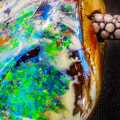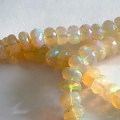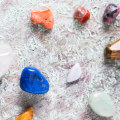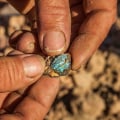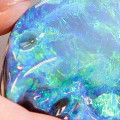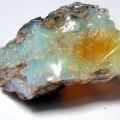The play of colors you see in opal is due to millions of tiny silica spheres of different sizes. These spheres refract light and cause the beautiful spectral colors seen in an opal. The spheres have to be just the right size and of a uniform nature to create enough color for our eyes to see. Opal is arguably the most unique, diverse and beautiful birthstone.
Unlike most gems, opal is amorphous, meaning it doesn't have a definite crystal structure. It takes many shapes and colors and, in that way, is quite unpredictable. This captivating miracle of nature has been admired by people around the world for centuries and highly sought after for use in jewelry, museums and collectibles. Opal is undoubtedly the most beautiful of all gems, at least it is unique and a true treasure of the earth.
The very idea that such magnificent colors have been hidden under the earth in darkness since ancient times, and that they have been taken out of the ground to show their opalescence in daylight, is truly astonishing. In precious opal, silica spheres are layered and packed evenly and regularly. When white light, for example sunlight, hits the layers of spheres and spaces in between, it is divided into a full spectrum of wonderful colors. Wearing opal as a jewelry stone is a relatively modern practice.
However, in ancient times, people used this stone for several reasons. Many considered opal to be beneficial to the eye and used it to cure eye diseases. Some even believed that it could make the carrier invisible. Supposedly, wearing an opal wrapped in a fresh bay leaf would prevent others from seeing you.
This superstition earned the opal the popular designation of patronus furum, which in Latin means “patron of thieves”. The body color of an opal is very important to its value.
opals
with black body are more valuable than any other shade, for example, blue, white, orange or colorless. One factor to consider within the main body color is the tone.When all other factors are equal, the deeper the tone, the better; for example, black opals with a lighter shade would be gray and are believed to be less desirable. There are many factors that affect the value of opal; type, color, brightness, transparency, shape and “color bar”, which are explained in this beginner's guide. Opal jewelry is beautiful but a little fragile, so it's best to take off beauties during activities when physical damage may occur. Opal with a thin colored bar can still reach prices of thousands or even tens of thousands of pounds.
It was once believed that opals were amorphous, without a crystalline structure, but it is now known that opal is often formed as very small spheroids. Opals can also contain aquamarine and purple, as well as the other “non-primary” colors that occur when two primary colors are combined. For this reason, the presence of red in an opal can add a lot of value to its value, since it is something rare. Unlike any other gem, opals can display all the colors of the rainbow in an iridescent and mobile pattern of red, green, blue, yellow, purple, aquamarine, pink and any other color you can imagine.
Opal can also slowly replace the exoskeletons of many marine organisms or wood, creating beautiful bright fossils. Before concluding, some opals have patterns that are unique and, therefore, the owner or retailer names them accordingly, respectively. The play of colors occurs because the light entering the opal will pass through the gaps between the silica spheres. In my opinion, the factors that are considered most important when valuing opal in the commercial gem trade are the dominant colors seen with regard to the play of colors and the extent of the play of colors throughout the stone.
Perhaps extending to the topic of invisibility, some believe that opals help in astral projection, a state of definite invisibility. The color bar is the area of the opal that “maintains” the play of colors, especially in boulder opal. But what causes the colors of an opal? What is different about opal that makes colors dance and play all over the face and burn in every color of the spectrum?. Opal is known for its bright and colorful spectrum and wide range of distinctive patterns, with its most famous attribute being its “play of colors”.
. .



